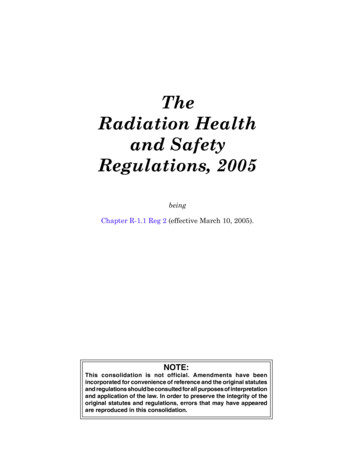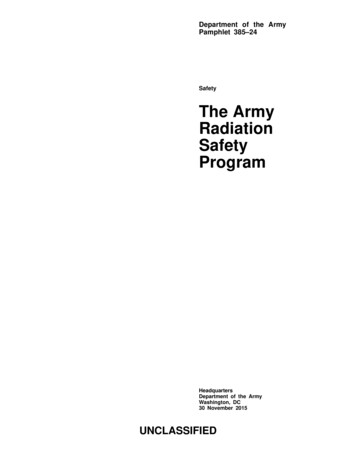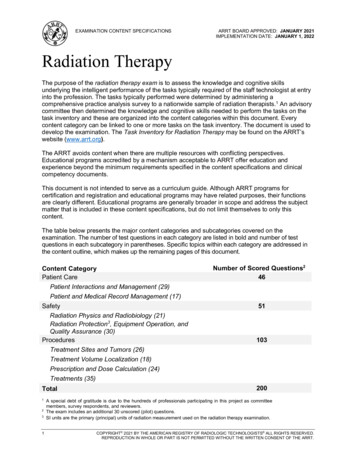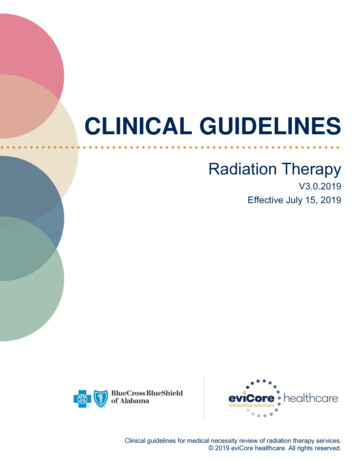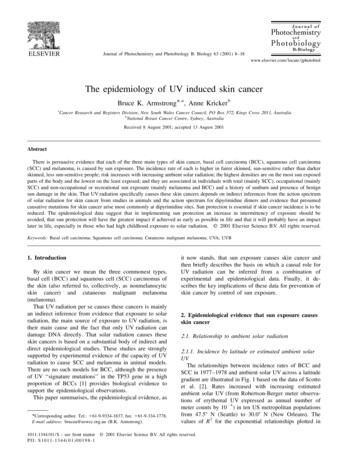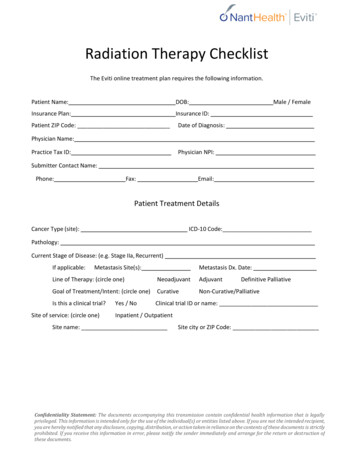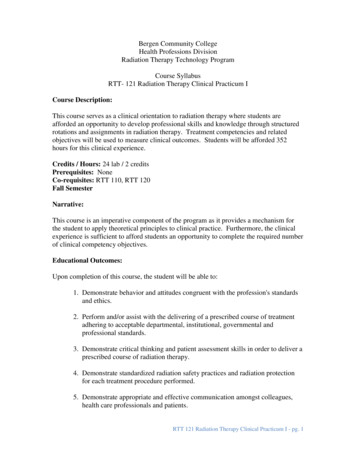
Transcription
Radiation Therapy and You:Support for People with CancerU.S. Department of Health & Human Services National Institutes of Health
The Use of Product or Brand NamesProduct or brand names that appear in this booklet are for example only. The U.S.Government does not endorse any specific product or brand. If products or brandsare not mentioned, it does not mean or imply that they are not satisfactory.1-800-4-CANCER (1-800-422-6237)
About this BookletRadiation Therapy and You is for you, if you are about to have or are now having radiationtherapy for cancer. People who are close to you may also find this booklet helpful.Rather than read this booklet from beginning to end, look at only those sections you neednow. Later, you can always read more.This booklet covers:Î Questions and Answers about Radiation Therapy. Answers to common questions,such as what radiation therapy is and how it affects cancer cells.Î External Beam and Internal Radiation. Information about the two main types ofradiation therapy.Î Side Effects and Ways to Manage Them. Information about side effects that may occur,depending on the part of your body being treated, and ways you can manage them.Î Questions to Ask. Questions for you to think about and discuss with your doctor,nurse, and others involved in your treatment and care.Î Lists of Foods and Liquids. Suggestions for foods and drinks that can help withside effects.Talk with your doctor and nurse about the information in this booklet. They may suggestthat you read certain sections or follow specific tips. Because radiation therapy affectspeople in different ways, they may also tell you that some of the information in this bookletdoes not apply to you.- - - - - - - - - - - - - - - - - - - - - - - - - - - - - - - - - - - - - - - - - - - - - - - - - - - - - - -Rather than read this book from beginning to end—look at onlythose sections you need now. Later, you can always read more.- - - - - - - - - - - - - - - - - - - - - - - - - - - - - - - - - - - - - - - - - - - - - - - - - - - - - - - - -www.cancer.govi
Table of ContentsQuestions and Answers about Radiation Therapy . 1External Beam Radiation Therapy . 9Internal Radiation Therapy . 15Radiation Therapy Side Effects . 19Treatment Areas and Possible Side Effects.21Ways to Manage Side Effects.22Diarrhea .22Fatigue .24Hair Loss .27Mouth Changes .30Nausea and Vomiting .34Sexual and Fertility Changes .36Skin Changes .40Throat Changes .43Urinary and Bladder Changes .45Late Effects .47Questions to Ask Your Doctor or Nurse . 49Lists of Foods and Liquids . 51Clear Liquids .51Low-Fiber Foods .52Foods and Drinks that Are High in Calories or Protein .53Foods and Drinks that Are Easy on the Stomach .54- - - - - - - - - - - - - - - - - - - - - - - - - - - - - - - - - - - - - - - - - - - - - - - - - - - - - - -Rather than read this book from beginning to end—look at onlythose sections you need now. Later, you can always read more.- - - - - - - - - - - - - - - - - - - - - - - - - - - - - - - - - - - - - - - - - - - - - - - - - - - - - - - - -www.cancer.goviii
Questions and Answers about Radiation TherapyWhat is radiation therapy?Radiation therapy (also called radiotherapy) is a cancer treatment that useshigh doses of radiation to kill cancer cells and shrink tumors. At low doses,radiation is used as an x-ray to see inside your body and take pictures, such asx-rays of your teeth or broken bones.How is radiation therapy given?Radiation therapy can be external beam or internal. External beam involvesa machine outside your body that aims radiation at cancer cells. Internalradiation therapy involves placing radiation inside your body, in or nearthe cancer. Sometimes people get both forms of radiation therapy. To learnmore about external beam radiation therapy, see page 9. To learn more aboutinternal radiation therapy, see page 15.Who gets radiation therapy?Many people with cancer need treatment with radiation therapy. In fact,more than half (about 60%) of people with cancer have radiation therapy.Sometimes, radiation therapy is the only kind of cancer treatment people have.What does radiation therapy do to cancer cells?Given in high doses, radiation kills or slows the growth of cancer cells.Radiation therapy is used to:Î Treat cancer. Radiation can be used to cure cancer, to prevent it fromreturning, or to stop or slow its growth.Î Reduce symptoms. When a cure is not possible, radiation may be usedto treat pain and other problems caused by the cancer tumor. Or, it canprevent problems that may be caused by a growing tumor, such as blindnessor loss of bowel and bladder control.www.cancer.gov1
How long does radiation therapy take to work?Radiation therapy does not kill cancer cells right away. It takes days or weeksof treatment before cancer cells start to die. Then, cancer cells keep dying forweeks or months after radiation therapy ends.What does radiation therapy do to healthy cells?Radiation not only kills or slows the growth ofcancer cells, it can also affect nearby healthy cells.The healthy cells almost always recover aftertreatment is over. But sometimes people may haveside effects that are severe or do not get better.Other side effects may show up months or yearsafter radiation therapy is over. These are called lateside effects.Doctors try to protect healthy cells during treatment by:ÎÎ Using as low a dose of radiation as possible. The radiation dose isbalanced between being high enough to kill cancer cells, yet low enough tolimit damage to healthy cells.ÎÎ Spreading out treatment over time. You may get radiation therapy oncea day, or in smaller doses twice a day for several weeks. Spreading out theradiation dose allows normal cells to recover while cancer cells die.ÎÎ Aiming radiation at a precise part of your body. Some types ofradiation therapy allow your doctor to aim high doses of radiation at yourcancer while reducing radiation to nearby healthy tissue. These techniquesuse a computer to deliver precise radiation doses to a cancer tumor or tospecific areas within the tumor.Does radiation therapy hurt?No, radiation therapy does not hurt while it is being given. But the side effectsthat people may get from radiation therapy can cause pain and discomfort.This booklet has a lot of information about ways that you and your doctor andnurse can help manage side effects.21-800-4-CANCER (1-800-422-6237)
Is radiation therapy used with other types of cancer treatment?Yes, radiation therapy is often used with other cancer treatments. Here aresome examples:Î Radiation therapy and surgery. Radiation may be given before, during,or after surgery. Doctors may use radiation to shrink the size of the cancerbefore surgery, or they may use radiation after surgery to kill any cancercells that remain. Sometimes, radiation therapy is given during surgery,so that it goes straight to the cancer without passing through the skin.Radiation therapy given during surgery is called intraoperative radiation.Î Radiation therapy and chemotherapy. Radiation may be givenbefore, during, or after chemotherapy. Before or during chemotherapy,radiation therapy can shrink the cancer so that chemotherapy worksbetter. After chemotherapy, radiation therapy can be used to kill anycancer cells that remain.Is radiation therapy expensive?Yes, radiation therapy costs a lot of money. It uses complex machines andinvolves the services of many health care providers. The exact cost of yourradiation therapy depends on the cost of health care where you live, whatkind of radiation therapy you get, and how many treatments you need.Talk with your health insurance company about what services it will pay for.Most insurance plans pay for radiation therapy. To learn more, talk with thebusiness office of the clinic or hospital where you go for treatment. If you needfinancial assistance, there are organizations that may be able to help. To findsuch organizations, go to the National Cancer Institute database, Organizationsthat Offer Support Services at:supportorgs.cancer.govand search “financial assistance.”Or call toll-free 1-800-4-CANCER(1-800-422-6237) to ask for informationon organizations that may help.www.cancer.gov3
Should I follow a special diet while I am getting radiation therapy?Your body uses a lot of energy to heal during radiation therapy. It isimportant that you eat enough calories and protein to keep your weight thesame during this time. Ask your doctor or nurse if you need a special dietwhile you are receiving radiation therapy. You might also find it helpful tospeak with a dietitian.To learn more about foods anddrinks that are high in calories orprotein, see the chart on page 53. Youmight also read Eating Hints: Before,During, and After Cancer Treatment,a booklet from the National CancerInstitute, at: ng-hints.Can I continue to work during radiation therapy?Some people are able to work full time during radiation therapy. Others canwork only part time or not at all. How much you are able to work dependson how you feel. Ask your doctor or nurse what you may expect from thetreatment you will have.You are likely to feel well enough to work when you first start your radiationtreatments. As time goes on, do not be surprised if you are more tired, haveless energy, or feel weak. Once you have finished treatment, it may take a fewweeks or many months for you to feel better.You may get to a point during your radiation therapy when you feel too sickto work. Talk with your employer to find out if you can go on medical leave.Make sure that your health insurance will pay for treatment while you are onmedical leave.- - - - - - - - - - - - - - - - - - - - - - - - - - - - - - - - - - - - - - - - - - - - - - - - - - - - - - -Ask your doctor, nurse, or dietitian if you need a special diet whileyou are getting radiation therapy.- - - - - - - - - - - - - - - - - - - - - - - - - - - - - - - - - - - - - - - - - - - - - - - - - - - - - - - - -41-800-4-CANCER (1-800-422-6237)
How can I cope with my feelings during radiation therapy?Living with cancer and going through treatment can be very stressful. It isnormal to feel anxious, depressed, afraid, angry, frustrated, helpless, or aloneat some point during radiation therapy. But there are ways you can learn tocope with these feelings.Many people find it helpful to talk with others who are going through thesame thing. To meet others, think about joining a support group. These groupsmeet in-person and online. You might also try relaxation or meditationexercises. Some people find prayer helpful.Exercise can also boost your mood. Try activities such as walking, biking,yoga, or water aerobics. Check with your doctor or nurse about types ofexercise that you can safely do during treatment.To learn more about coping with your feelings during cancer treatment:Î Visit the Coping section of the National Cancer Institute’s website at:www.cancer.gov/about-cancer/copingÎ Read Taking Time: Support for People with Cancer aking-timeFor relaxation exercises:Î Visit Learning to Relax on the National Cancer Institute’swebsite at: tionÎ See Facing Forward: Life After Cancer Treatment acing-forwardwww.cancer.gov5
How do I make the most of radiation therapy?You have an important role to play in your radiation therapy. To get the mostfrom this treatment:Î Arrive on time for all radiation therapy sessions.Î Ask questions and talk about your concerns.Î Tell someone on your radiation therapy team when you have side effectsand changes with eating or bowel habits.Î Tell your doctor or nurse if you are in pain.Follow the advice of your doctors and nurses about how to care for yourself athome, such as:Î Taking care of your skinÎ Drinking enough liquidsÎ Eating foods to help with side effectsÎ Maintaining your weight- - - - - - - - - - - - - - - - - - - - - - - - - - - - - - - - - - - - - - - - - - - - - - - - - - - - - - -Make a list of questions and problems you want to discuss with yourdoctor or nurse. Be sure to bring this list to your follow-up visits. Seepages 49 and 50 for sample questions.- - - - - - - - - - - - - - - - - - - - - - - - - - - - - - - - - - - - - - - - - - - - - - - - - - - - - - -Be sure to arrive on time for ALL radiation therapy sessions.- - - - - - - - - - - - - - - - - - - - - - - - - - - - - - - - - - - - - - - - - - - - - - - - - - - - - - - - -61-800-4-CANCER (1-800-422-6237)
What happens when radiation therapy is over?Once you have finished radiation therapy, you will need follow-up carefor the rest of your life. Follow-up care refers to regular checkups oncetreatment is over. During these checkups, your doctor or nurse will seehow well the radiation therapy worked, check for signs of cancer, talk withyou about your treatment and care, and look for late side effects. Late sideeffects are those that occur six or more months after you have completedradiation therapy. During these checkups, your doctor or nurse will:Î Examine you and review how you have been feeling. Your doctorcan prescribe medicine or suggest other ways to treat any side effectsyou may have.Î Order lab and imaging tests, which are tests that make pictures of areasinside the body. These tests may include blood tests, x-rays, or CT, MRI, orPET scans.Î Discuss treatment. Your doctor may suggest that you have moretreatment, such as extra radiation treatments, chemotherapy, or other typesof treatment.Î Answer your questions and respond to your concerns. It may behelpful to write down your questions ahead of time and bring them withyou. You can find sample questions on pages 49 and 50.For more information about late effects, visit the National Cancer Institute’swebsite at te-effects.After I have finished radiation therapy, what symptoms should I look for?You have gone through a lot with cancer and radiation therapy.Now you may be even more aware of your body and how youfeel each day. Pay attention to changes in your body. Tell yourdoctor or nurse if you have:Î A pain that does not go awayÎ New lumps, bumps, swellings, rashes, bruises, or bleedingÎ Appetite changes, nausea, vomiting, diarrhea, or constipationÎ Weight loss that you cannot explainÎ A fever, cough, or hoarseness that does not go awayÎ Any other symptoms that worry youwww.cancer.gov7
External Beam Radiation TherapyWhat is external beam radiation therapy?External beam radiation therapy comes from a machine that aims radiationat your cancer. The machine is large and may be noisy. It does not touchyou, but it can move around you, sending radiation to your body frommany directions.External beam radiation therapy is a local treatment, meaning that theradiation treats a specific part of your body. For example, if you have lungcancer, you will have radiation only to your chest, not to the rest of your body.External beam radiation therapy comes from a machine that aims radiationat your cancer.www.cancer.gov9
How often will I have external beam radiation therapy?Most people have external beam radiation therapy once a day, five days aweek, Monday through Friday. Treatment lasts anywhere from 2 to 10 weeks,depending on the type of cancer you have and the goal of your treatment. Thisspan of time is called a course of treatment.Radiation therapy may also be given on other schedules. These schedulesinclude:Î Accelerated fractionation, which is treatment given in larger daily orweekly doses to reduce the number of weeks of treatmentÎ Hyperfractionation, which issmaller doses of radiation givenmore than once a dayÎ Hypofractionation, which islarger doses given once a day (orless often) to reduce the numberof treatmentsYour doctor may prescribe one ofthese treatment schedules if he or shefeels that it will work better for you.Where do I go for external beam radiation therapy?Most of the time, you will get external beam radiation therapy as anoutpatient. This means that you will have treatment at a clinic or radiationtherapy center and will not have to stay in the hospital.101-800-4-CANCER (1-800-422-6237)
What happens before I begin external beam radiation treatment?You will have a one- to two-hour meeting with your doctor or nurse beforeyou begin radiation therapy. At this time, you will have a physical exam, talkabout your medical history, and may have imaging tests. Your doctor or nursewill discuss external beam radiation therapy, its benefits and side effects,and ways you can care for yourself during and after treatment. You can thenchoose whether to have external beam radiation therapy.If you decide to have external beam radiation therapy, you will be scheduledfor a treatment planning session called a simulation. At this time:Î A radiation oncologist (a doctor who specializes in using radiation to treatcancer) and radiation therapist will define your treatment area. You mayalso hear the treatment area referred to as the treatment port or treatmentfield. These terms refer to the places in your body that will receive radiation.You will be asked to lie very still while x-rays or scans are taken.Î The radiation therapist will put small marks (either tattoos or dots ofcolored ink) on your skin to mark the treatment area. These marks areneeded throughout your course of radiation therapy. The radiation therapistwill use them each day to make sure you are in the correct position. Tattoosare about the size of a freckle and will remain on your skin for the rest ofyour life. Ink markings will fade over time. Be careful not to remove themand tell the radiation therapist if they have faded or lost color.A body mold may be made of the part of the body that is being treated. This isa plastic or plaster form that keeps you from moving during treatment. It alsohelps make sure that you are in the exact same position each day of treatment.You may be fitted for a mask, if you are gettingradiation to the head and neck area. The mask hasair holes. It attaches to the table where you willlie for your treatments. The mask helps keep yourhead from moving so that you are in the exactsame position for each treatment.If using the body mold or mask makes you feelanxious, see page 13 for ways to relax duringtreatment.If you are getting radiationto the head, you may needa mask.www.cancer.gov11
What should I wear for external beam radiation therapy?Wear clothes that are comfortable and made of soft fabric, such as fleece orcotton. Choose clothes that are easy to take off, because you may need to pullthem away from the treatment area or change into a hospital gown. Do notwear clothes that are tight, such as close-fitting collars or waistbands, nearyour treatment area. Also, do not wear jewelry, adhesive bandages, or powderin the treatment area.What happens during a treatment session?Î You may be asked to change into a hospital gown or robe.Î You will go to the treatment room where you will receive radiation.Î Depending on where your cancer is, you will either sit in a chair or liedown on a treatment table. The radiation therapist will use your skinmarks and body mold or face mask, if you have one, to help you get intothe correct position.Î You may see colored lights pointed at your skin marks. These lights areharmless and help the therapist position you for treatment each day.Î You will need to stay very still so the radiation goes to the exact sameplace each time. You will get radiation for one to five minutes. During thistime, you can breathe normally and do not have to hold your breath.The radiation therapist will leave the room just before your treatment begins.He or she will go to a nearby room to control the radiation machine. Thetherapist can watch you on a TV screen or through a window and talk withyou through a speaker in the treatment room. Be sure to tell the therapist ifyou feel sick or are uncomfortable. He or she can stop the radiation machine atany time. You won’t be able to feel, hear, see, or smell the radiation.Your entire visit may last from 30 minutes to an hour. Most of that time isspent placing you in the correct position. Certain types of radiation maytake longer. Your visit may also take longer if your treatment team needs totake and review x-rays.121-800-4-CANCER (1-800-422-6237)
Will external beam radiation therapy make me radioactive?No, external beam radiation therapy does not make people radioactive.You may safely be around other people, even pregnant women, babies, andyoung children.How can I relax during my treatment sessions?Î Bring something to keep you busy in the waiting room, such as a book ormagazine, crossword puzzles, or knitting.Î Use headphones to listen to music or recorded books.Î Meditate, breathe deeply, pray, use imagery, or find other ways to relax. Forrelaxation exercises: Visit Learning to Relax on the National Cancer Institute’s websiteat: tion See Facing Forward: Life After Cancer Treatment acing-forward- - - - - - - - - - - - - - - - - - - - - - - - - - - - - - - - - - - - - - - - - - - - - - - - - - - - - - -Your radiation therapist can see, hear, and talk with you at all timeswhile you are receiving external beam radiation therapy.- - - - - - - - - - - - - - - - - - - - - - - - - - - - - - - - - - - - - - - - - - - - - - - - - - - - - - - - -www.cancer.gov13
Internal Radiation TherapyWhat is internal radiation therapy?Internal radiation therapy is a form of treatment in which a source ofradiation is put inside your body. One form of internal radiation therapyis called brachytherapy. In brachytherapy, a solid radiation source, such asseeds, ribbons, or capsules, is placed in your body in or near the cancer.Internal radiation can also be in liquid form. You receive liquid radiation bydrinking it, swallowing a pill, or getting it through an IV line. Liquid radiationtravels throughout your body, seeking out and killing cancer cells.Brachytherapy may be used to treat many types of cancers, such as cancersof the head and neck, breast, uterus, cervix, prostate, gallbladder, esophagus,eye, and lung. Liquid forms of internal radiation are most often used to treatthyroid cancer or non-Hodgkin lymphoma.What happens before I begin internal radiation therapy?You will have a 1- to 2-hour meeting with your doctor or nurse to planyour treatment before you begin internal radiation therapy. At this time,you will have a physical exam, talk about your medical history, and mayhave imaging tests. Your doctor will discuss the type of internal radiationtherapy that is best for you, its benefits and side effects, and ways you cancare for yourself during and after treatment. You can then decide whetherto have internal radiation therapy.How is brachytherapy put in place?Most brachytherapy is put in place through a catheter, which is a small,stretchy tube. Sometimes, brachytherapy is put in place through a larger devicecalled an applicator. Your doctor will place the catheter or applicator into yourbody before you begin treatment.Once the catheter or applicator is in place, the radiation source will beplaced inside. The radiation source may be kept in place for a few minutes,for many days, or for the rest of your life. How long the radiation sourceremains in place depends on the type of brachytherapy you have, your typeof cancer, where the cancer is in your body, your health, and other cancertreatments you have had.www.cancer.gov15
What are the types of brachytherapy?There are three types of brachytherapy:Î Low-dose rate (LDR) implants. In this type of brachytherapy, theradiation source stays in place for one to seven days. You are likely to bein the hospital during this time. Once your treatment is finished, yourdoctor will remove the radiation source and the catheter or applicator.Î High-dose rate (HDR) implants. In this type of brachytherapy, theradiation source is left in place for just 10 to 20 minutes at a time and thentaken out. You may have treatment twice a day for two to five days or oncea week for two to five weeks. The schedule depends on your type of cancer.During the course of treatment, your catheter or applicator may stay inplace, or it may be put in place before each treatment. You may be in thehospital during this time, or you may make daily trips to the hospital tohave the radiation source put in place. As with LDR implants, your doctorwill remove the catheter or applicator once you have finished treatment.Î Permanent implants. After the radiation source is put in place, thecatheter is removed. The implants always stay in your body, but theradiation gets weaker each day. As time goes on, almost all radiation will goaway. When the radiation is first put in place, you may need to limit yourtime around other people. Be extra careful not to spend time with childrenor pregnant women.What happens while the radiation is in place?With brachytherapy, your body fluids (urine, sweat, and saliva) will not giveoff radiation, but the radiation source will. With liquid radiation, your bodyfluids will give off radiation for a while.If the radiation you receive is a very high dose, safety measures may include:Î Staying in a private hospital room to protect others from radiation comingfrom your body.Î Being treated quickly by nurses and other hospital staff. They will provideall the care you need, but they may stand at a distance and talk with youfrom the doorway to your room.161-800-4-CANCER (1-800-422-6237)
Your visitors will also need to followsafety measures, which may include:Î Not being allowed to visit whenthe radiation is first put inÎ Needing to check with the hospitalstaff before they go to your roomÎ Keeping visits short (30 minutes or less each day). The length of visitsdepends on the type of radiation being used and the part of your bodybeing treated.Î Standing by the doorway rather than going into your hospital roomÎ Not having visits from pregnant women and children younger thana year oldYou may also need to follow safety measures once you leave the hospital,such as not spending much time with other people. Your doctor or nursewill talk with you about any safety measures you should followwhen you go home.What happens when the catheter is taken out after treatment withLDR or HDR implants?Î You will get medicine for pain before the catheter or applicator is removed.Î The area where the catheter or applicator was might be tender fora few months.Î There is no radiation in your body after the catheter or applicator isremoved. It is safe for people to be near you—even young children andpregnant women.Î For a week or two, you may need to limit activities that take a lot of effort.Ask your doctor what kinds of activities are safe for you and which onesyou should avoid.- - - - - - - - - - - - - - - - - - - - - - - - - - - - - - - - - - - - - - - - - - - - - - - - - - - - - - -Tell your doctor or nurse if you are in pain.- - - - - - - - - - - - - - - - - - - - - - - - - - - - - - - - - - - - - - - - - - - - - - - - - - - - - - - - -www.cancer.gov17
Radiation Therapy Side EffectsSide effects are problems that can occur as a result of treatment. They may occur withradiation therapy because the high doses of radiation that are used to kill cancer cells canalso damage healthy cells in the treatment area. Side effects are different for each person.Some people have many side effects. Others have hardly any. Side effects may be moresevere if you also receive chemotherapy before, during, or after your radiation therapy.Talk with your doctor or nurse about your chances of having side effects. The team willwatch you closely and ask if you notice a
Or call toll-free 1-800-4-CANCER (1-800-422-6237) to ask for information on organizations that may help. 4. 1-800-4-CANCER (1-800-422-6237) Should I follow a special diet while I am getting radiation therapy? Your body uses a lot of energy to heal during radiation therapy. It is

